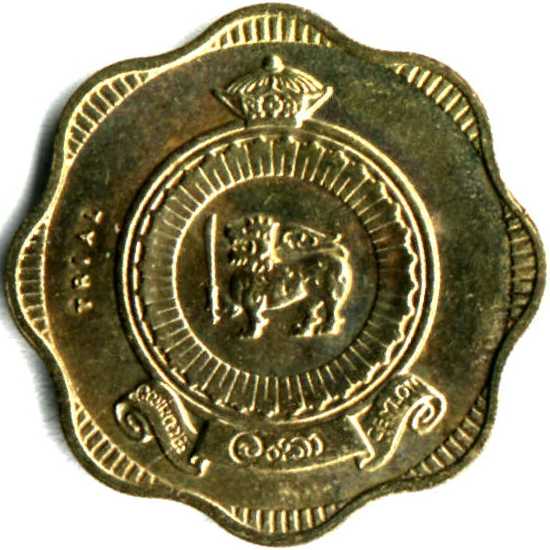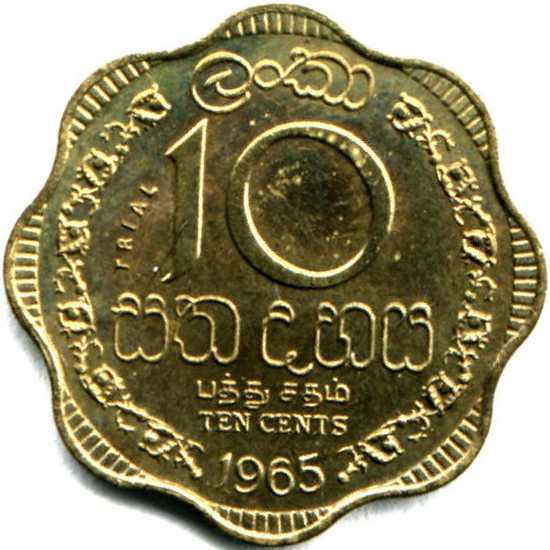1965 -1968 - Lanka
Ten & Five Cents - TRIAL
A pair of TRIAL patterns struck most probably in Birmingham Mint
in 1965 and 1968 of same weight and Nickel-Brass alloy for the standard
Five cents coin and
Ten cents coin denominations
which were first struck few years previously in 1963 at British Royal
Mint (BRM).
They are therefore unlike the 1971 Off-Metal-struck TRIAL patterns of
both Five cents and
Ten cents denominations in
Nickel-Brass clad steel, Chromized steel, and Aluminum with word TRIAL
in raised letters on Obverse at 2 O'clock.
| SPECIFICATIONS |
| Denomination | Ten cents |
| Alloy | Nickel-Brass |
| Diameter | 23.11/20.96 mm |
| Thickness | 1.55 mm |
| Weight | 4.29 gms |
| Shape | eight scallops |
| Edge | Plain |
| Die-Axis | 0° |
| Known | Unique |
|

|

|
| KM unlisted |
| Denomination | Five cents |
| Alloy | Nickel-Brass |
| Diameter | 21.46/18.24 mm |
| Thickness | 1.50 mm |
| Weight | 3.18 gms |
| Shape | Square with
round corners |
| Edge | Plain |
| Die-Axis | 0° |
| Known | 7 |
|

|

|
| KM unlisted |
Obverse : The Armorial Ensign of Ceylon with
இலங்கை in Thamil on left,
ලංකා in Sinhala in middle,
and CEYLON on left in a scroll at its bottom. All within raised rim.
Raised word TRIAL to the left (9 O'Clock) along the periphery.
Reverse : The large numeral denomination with big
සත value in Sinhala,
and smaller value
சதம் in Thamil, and
value CENTS below and year of issue 196x at the bottom,
with traditional Sinhala Liyavela art on either side, and country name
ලංකා (Lanka)
in Sinhala centered on top. All within raised rim.
Raised word TRIAL to the left and upper side (10 O'clock)
just inside the Liyavela.
Finding out the details of their true origin was real serendipity.
I first saw these TRIALs for sale on the Internet in 1998 August and was
curious what they were. Two years later after I saw the 1971 TRIAL
series, I suspected these to be fantasy creations on regular issue.
They have been minted with the same weight and metal composition
(non-magnetic) of the standard issue of those years and have been minted a
few years after this coin type was first issued in 1963.
In 2002 September I requested them on approval to investigate.
I found that the raised lettering TRIAL looked real
even under the 150X magnification of my recently acquired
microscope. I then started my investigation of their
origin more seriously.
I first asked Ed Krivoniak, a leading collector in Pittsburgh who had
told me about his TRIAL coins from New Zealand. He confirmed that some
commonwealth TRIALs accepted to be genuine were known, which were not
of first year of issue.
In reply to a question on
southasia-coins,
Mr Paul Baker
pointed out that a sub-contract mint to the BRM would not
necessarily start making coins right from the first year of a
type. The letter-head illustrated in his Birmingham Mint
webpage on the Kings
Norton Mint closure in 1991 includes this Ceylon 5 Cents (KM-129), among
other coins and tokens.
There are many examples where the same coin type was minted in different
locations. Occasionally there is a mint mark like in the
H in the 1912 5 cents
coin or the
B in the silver 1919/20/21
coins of the George V series.
The Royal Mint Annual Report for 1969 states that in 1969 about 45% of the
overseas orders for coins were struck under sub-contract by
Imperial Metal Industries (Kynoch) and the Mint Birmingham, Ltd.
They do not however distinguish which of these Mints or the Royal Mint
Struck the any of the listed coin types.
Then finally the curator of the British Royal Mint Museum confirmed
that their coin cabinet did have six specimens of the 1968
5 cents TRIAL with a ticket which says they were sent to them in
the early 1970's from the Birmingham Mint.
This striking was an unusual occurrence since most TRIALs are struck at the
British Royal Mint.
Visiting the British Royal Mint Museum on 2005 June 24th I was able to
confirm that the 1965 10 cents TRIAL is not in their coin
cabinet, and therefore thought it maybe unique.
However in 2012 September, Heritage Coin Auction Lot #3020 a PCGS Slabbed SP64, 1965 10-cent trial sold for US$440.
If you know of any other TRIAL specimen please
E-mail me.
In August 2005 the IMI-Birmingham Mint coin collection was
gifted
to the Birmingham
Museum
after being sorted and valued by
Format
Coins. Duplicates in that collection were sold in the late
1960's. I need to check if that collection has a specimen of the
Ceylon 1965 10-cent TRIAL.
Since the TRIALs were made to check on a subcontract, none would have been
sent to Ceylon and explains why there is no record of this TRIAL
in the Central Bank of Ceylon and could not be a source.
The Royal Mint does not send specimens of TRIAL coins to anyone else
not even to the British Museum.
By an amazing coincidence less than 2-days after I requested the
TRIALs above on approval, a 1971 Chromarized Steel TRIAL of 10 cents
coin was listed for the first time on ebay by a collector in Belgium.
On 2002 Sept 11, I won this TRIAL and the seller said
I purchased the trial coin 15 or maybe 20 years ago from a
person who worked at a Belgian factory of non-ferro metals.
The factory often melted coins for recycling the metals and got the
coins from a Mint house to re-melt, I suppose . This coin was a part
of a group of normal and common minor coins in different metals. So
the worker saved the coin from melting and I was lucky that I saw the
word TRIAL and the used metal.
When I inquired about the Royal Mint recycling on southasia-coins group
I was told that
Royal Mint practices did vary and scrap did go out of the mint -
their main problem was that they used quite a few different alloys
(for coins of 50+ medals etc) and when making blanks they needed
predictable raw materials to start with. The containers of odd bits,
floor sweepings miss-struck coins etc. were not of a predictable
metal content and so could not be easily recycled internally and so
were sold to outside contractors. Occasionally the mint did and does
buy in blanks - I think thus is for simple commercial or logistic
reasons.
They two above must have escaped to the numismatic market via the
same old lapse in security of the metal recycling.
The BU TRIAL pieces were scanned at 600 dpi and the images are
displayed at 300dpi. The coin can be seen at full resolution using
view image option of browser.
The two rare TRIAL pieces were obtained from Larry Van Huss of
Phoenix Enterprises, TN. USA,
who had purchased them many years previously from Paul Bickerman
of Coin Trends in Australia,
who unfortunately does not remember their source.
I thank Paul Baker, Graham Dyer, Larry Van Huss, Ed Krivoniak, Gust Sels,
and Howard Simmons who contributed significantly to information on this page.



